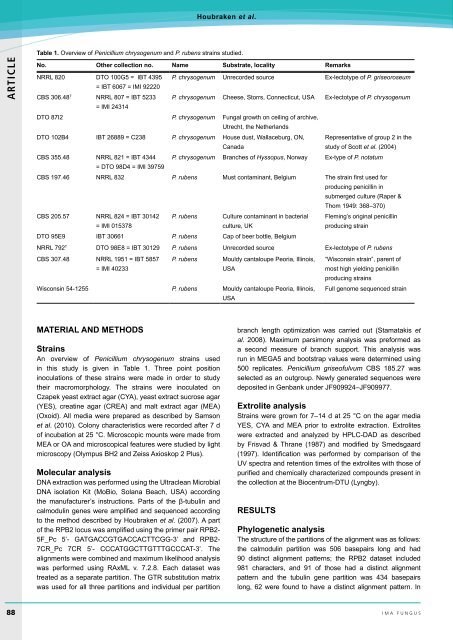Fleming's penicillin producing strain is not Penicillium - IMA Fungus
Fleming's penicillin producing strain is not Penicillium - IMA Fungus
Fleming's penicillin producing strain is not Penicillium - IMA Fungus
Create successful ePaper yourself
Turn your PDF publications into a flip-book with our unique Google optimized e-Paper software.
Houbraken et al.<br />
ARTICLE<br />
Table 1. Overview of <strong>Penicillium</strong> chrysogenum and P. rubens <strong>strain</strong>s studied.<br />
No. Other collection no. Name Substrate, locality Remarks<br />
NRRL 820 DTO 100G5 = IBT 4395 P. chrysogenum Unrecorded source Ex-lectotype of P. gr<strong>is</strong>eoroseum<br />
= IBT 6067 = IMI 92220<br />
CBS 306.48 T NRRL 807 = IBT 5233 P. chrysogenum Cheese, Storrs, Connecticut, USA Ex-lectotype of P. chrysogenum<br />
= IMI 24314<br />
DTO 87I2 P. chrysogenum Fungal growth on ceiling of archive,<br />
Utrecht, the Netherlands<br />
DTO 102B4 IBT 26889 = C238 P. chrysogenum House dust, Wallaceburg, ON,<br />
Canada<br />
Representative of group 2 in the<br />
study of Scott et al. (2004)<br />
CBS 355.48 NRRL 821 = IBT 4344 P. chrysogenum Branches of Hyssopus, Norway Ex-type of P. <strong>not</strong>atum<br />
= DTO 98D4 = IMI 39759<br />
CBS 197.46 NRRL 832 P. rubens Must contaminant, Belgium The <strong>strain</strong> first used for<br />
<strong>producing</strong> <strong>penicillin</strong> in<br />
submerged culture (Raper &<br />
Thom 1949: 368–370)<br />
CBS 205.57 NRRL 824 = IBT 30142<br />
= IMI 015378<br />
P. rubens Culture contaminant in bacterial<br />
culture, UK<br />
Fleming’s original <strong>penicillin</strong><br />
<strong>producing</strong> <strong>strain</strong><br />
DTO 95E9 IBT 30661 P. rubens Cap of beer bottle, Belgium<br />
NRRL 792 T DTO 98E8 = IBT 30129 P. rubens Unrecorded source Ex-lectotype of P. rubens<br />
CBS 307.48 NRRL 1951 = IBT 5857<br />
= IMI 40233<br />
P. rubens Mouldy cantaloupe Peoria, Illino<strong>is</strong>,<br />
USA<br />
“W<strong>is</strong>consin <strong>strain</strong>”, parent of<br />
most high yielding <strong>penicillin</strong><br />
<strong>producing</strong> <strong>strain</strong>s<br />
W<strong>is</strong>consin 54-1255 P. rubens Mouldy cantaloupe Peoria, Illino<strong>is</strong>,<br />
USA<br />
Full genome sequenced <strong>strain</strong><br />
Material and methods<br />
Strains<br />
An overview of <strong>Penicillium</strong> chrysogenum <strong>strain</strong>s used<br />
in th<strong>is</strong> study <strong>is</strong> given in Table 1. Three point position<br />
inoculations of these <strong>strain</strong>s were made in order to study<br />
their macromorphology. The <strong>strain</strong>s were inoculated on<br />
Czapek yeast extract agar (CYA), yeast extract sucrose agar<br />
(YES), creatine agar (CREA) and malt extract agar (MEA)<br />
(Oxoid). All media were prepared as described by Samson<br />
et al. (2010). Colony character<strong>is</strong>tics were recorded after 7 d<br />
of incubation at 25 °C. Microscopic mounts were made from<br />
MEA or OA and microscopical features were studied by light<br />
microscopy (Olympus BH2 and Ze<strong>is</strong>s Axioskop 2 Plus).<br />
Molecular analys<strong>is</strong><br />
DNA extraction was performed using the Ultraclean Microbial<br />
DNA <strong>is</strong>olation Kit (MoBio, Solana Beach, USA) according<br />
the manufacturer’s instructions. Parts of the β-tubulin and<br />
calmodulin genes were amplified and sequenced according<br />
to the method described by Houbraken et al. (2007). A part<br />
of the RPB2 locus was amplified using the primer pair RPB2-<br />
5F_Pc 5’- GATGACCGTGACCACTTCGG-3’ and RPB2-<br />
7CR_Pc 7CR 5’- CCCATGGCTTGTTTGCCCAT-3’. The<br />
alignments were combined and maximum likelihood analys<strong>is</strong><br />
was performed using RAxML v. 7.2.8. Each dataset was<br />
treated as a separate partition. The GTR substitution matrix<br />
was used for all three partitions and individual per partition<br />
branch length optimization was carried out (Stamatak<strong>is</strong> et<br />
al. 2008). Maximum parsimony analys<strong>is</strong> was preformed as<br />
a second measure of branch support. Th<strong>is</strong> analys<strong>is</strong> was<br />
run in MEGA5 and bootstrap values were determined using<br />
500 replicates. <strong>Penicillium</strong> gr<strong>is</strong>eofulvum CBS 185.27 was<br />
selected as an outgroup. Newly generated sequences were<br />
deposited in Genbank under JF909924–JF909977.<br />
Extrolite analys<strong>is</strong><br />
Strains were grown for 7–14 d at 25 °C on the agar media<br />
YES, CYA and MEA prior to extrolite extraction. Extrolites<br />
were extracted and analyzed by HPLC-DAD as described<br />
by Fr<strong>is</strong>vad & Thrane (1987) and modified by Smedsgaard<br />
(1997). Identification was performed by compar<strong>is</strong>on of the<br />
UV spectra and retention times of the extrolites with those of<br />
purified and chemically characterized compounds present in<br />
the collection at the Biocentrum-DTU (Lyngby).<br />
Results<br />
Phylogenetic analys<strong>is</strong><br />
The structure of the partitions of the alignment was as follows:<br />
the calmodulin partition was 506 basepairs long and had<br />
90 d<strong>is</strong>tinct alignment patterns; the RPB2 dataset included<br />
981 characters, and 91 of those had a d<strong>is</strong>tinct alignment<br />
pattern and the tubulin gene partition was 434 basepairs<br />
long, 62 were found to have a d<strong>is</strong>tinct alignment pattern. In<br />
88 ima fUNGUS
















